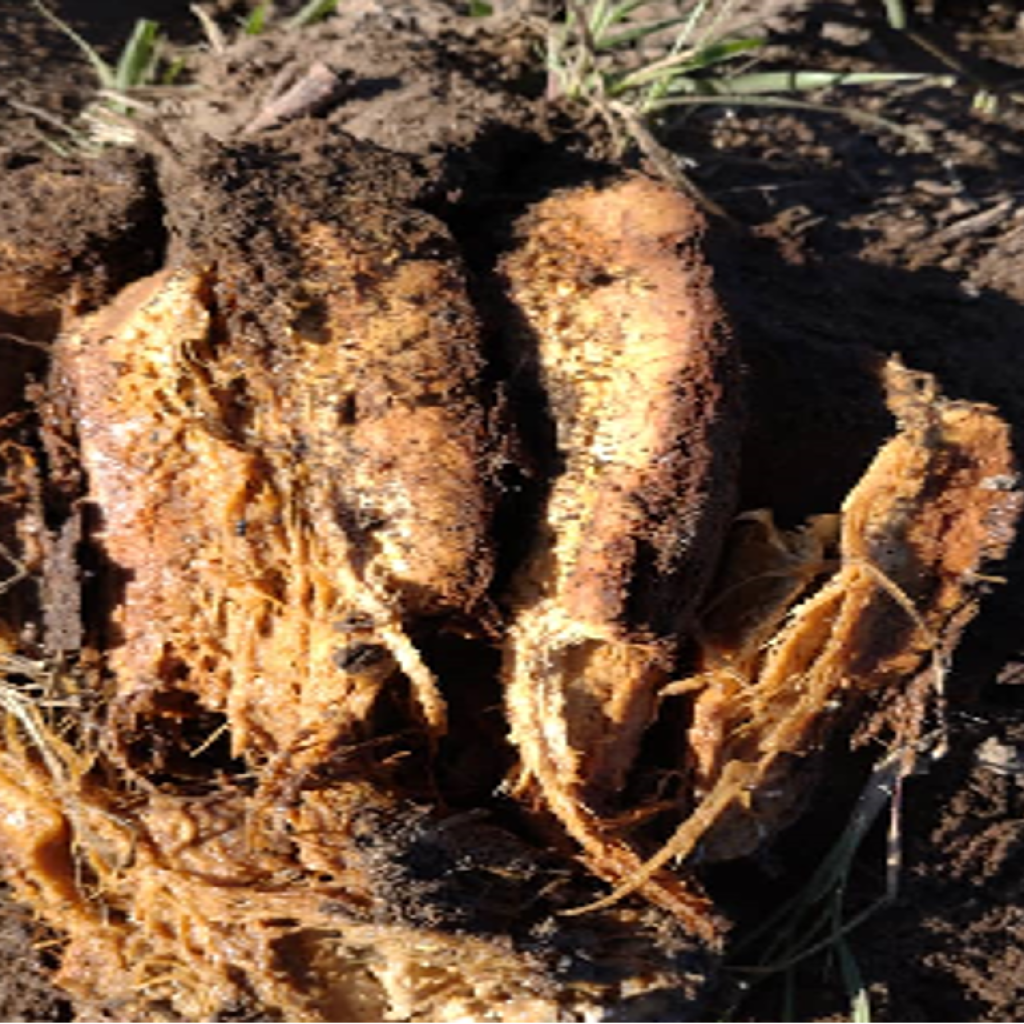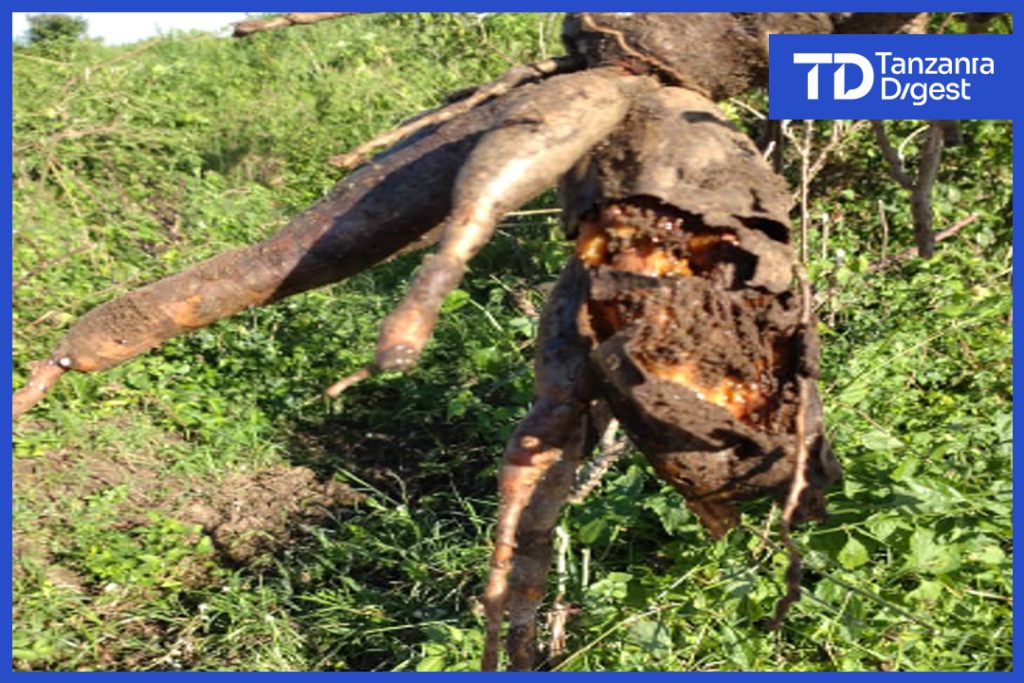In the rolling hills and river-cut valleys of Tanzania’s Mara Region, cassava has long stood as a pillar of survival. It’s not just a food crop, it is insurance. When the rains fail maize and the soils reject beans, cassava endures. It’s boiled for breakfast, pounded into kigumu, or dried and milled into flour that feeds generations.
But today, those once reliable roots are failing. Slowly. Silently.
Cassava plants that once stood tall now droop, twisted and yellowing. Beneath the surface, the roots rot before harvest. The local name is ominous gonjwa la mizizi, root disease. Scientists know it as Cassava Mosaic Disease (CMD) and Cassava Brown Streak Disease (CBSD), a dual viral assault crippling Tanzania’s second most important staple crop.
Nowhere is the devastation more severe than in Mara.
“I used to fill a truck with cassava every season. Now I can’t fill a wheelbarrow,” says Mama Stella, a farmer from Butiama, her voice heavy with quiet despair.
The story is the same from Butiama to Musoma. According to Tanzania’s National Plant Protection authorities, up to seven viral strains are attacking cassava in the region—making Mara one of the hardest-hit zones in Africa. For many farming families, the result is devastating: reduced yields, rotting harvests, and declining food security.

Brown steak disease
A New Root of Resistance
Yet amid this collapse, a scientific breakthrough is quietly waiting in the wings.
In modern greenhouses from Ibadan to Namulonge, researchers have developed genetically modified (GM) cassava varieties designed to resist both CMD and CBSD. These virus-resistant lines are thriving where traditional ones fail.
“This is one of the most promising tools we have for African food security,” says Dr. Leena Tripathi, molecular biologist at the International Institute of Tropical Agriculture (IITA). “The resistance is robust, and the roots remain healthy.”
Across field trials in East and West Africa, GM cassava has shown yields up to three times higher than susceptible varieties. Plants stay green. Roots stay clean. And families, once dependent on handouts, begin harvesting again.
This is more than just a crop, it’s a recovery strategy.
From Survival to Industry
Cassava’s potential goes beyond the plate.
For decades, communities in Mara dreamed of cassava-based industries, bioethanol plants, starch factories, glucose production lines. But the viral onslaught decimated those ambitions. Raw materials dwindled. Processors shut down. Jobs disappeared.
“The bioethanol sector could have transformed Tarime,” says Engineer Baraka Chacha, a former project lead at a cassava pilot plant. “But we lacked the consistent, high-quality supply to keep things running.”
Now, GM cassava could change that. High-starch, disease-free roots can keep factories working year-round. Tanzania currently imports industrial starch, yet has the agro ecology to export it instead. Reviving the cassava value chain could fuel new jobs, save foreign exchange, and spur rural transformation.
What’s Holding Us Back?
Despite the proven science, GM cassava remains locked out of Tanzanian farms. The country has biosafety laws, trained scientists, and secure laboratories. But policy action lags.
Some policymakers fear export backlash. Others cite the need for public consultation or political caution. Meanwhile, the science sits idle and so do the farmers.
“They say it works. They say it’s safe. Why can’t we plant it?” asks Mama Stella. “I just want cassava that grows.”
Tanzania has the capacity to lead—but fear of the unknown is costing us time, and livelihoods.
A Smart Step Forward
The solution is not a blanket approval. It’s a smart rollout focused on areas that need it most. Mara, with its catastrophic infection levels, is the natural starting point.
A bold, practical path could look like this: forge links between farmers and industrial processors to build an integrated value chain for starch, ethanol, and animal feed; and launch a nationwide public communication campaign featuring scientists, faith leaders, and farmers to explain the science in simple, relatable terms.
This is not about importing foreign solutions. It’s about activating African science for African food systems, with Tanzanian institutions in the lead.
Let the Roots Rise
Cassava is more than calories. It is tradition, resilience, and possibility. In Mara, it is also the front line in the battle for food security. We now stand at a crossroads: cling to fear or step forward with science.
Approving GM cassava for limited rollout in Mara is not a gamble. It is a calculated, evidence-based intervention—guided by 15 years of biosafety research, international trials, and African-led innovation.
“If it doesn’t rot, I’ll grow it,” Mama Stella says. “If it feeds my children, I’ll plant it.”
Let us not bury this opportunity under bureaucracy. Let us plant it in soil, in policy, in the hearts of farmers who have waited too long.
It’s time. Let the roots of hope grow again.
About the Authors
Rebeca Kachembeho is a science writer based in Tanzania. She is currently contributing to a research project on Public understanding of biotechnology at Sokoine University of Agriculture. Her reporting focuses on bridging research and rural realities, with a growing portfolio of work spotlighting underrepresented voices in African science.
Martinus Sospeter is a science communicator affiliated with Sokoine University of Agriculture. He reports on climate change and environmental policy, with a focus on how global dynamics shape the lives of smallholder farmers in Africa.
Jackline Martine is an emerging science journalist based in Tanzania. She specializes in agricultural innovation, technology adoption, and knowledge transfer. She affiliated with Sokoine University of Agriculture. Her work explores how science is interpreted and applied in farming communities in Africa.
.


Thanks a lot for sharing this
I’m from Mara region by origin, this disease highly affects not only agricultural production but also the financial and life status of the citizens in Mara region.